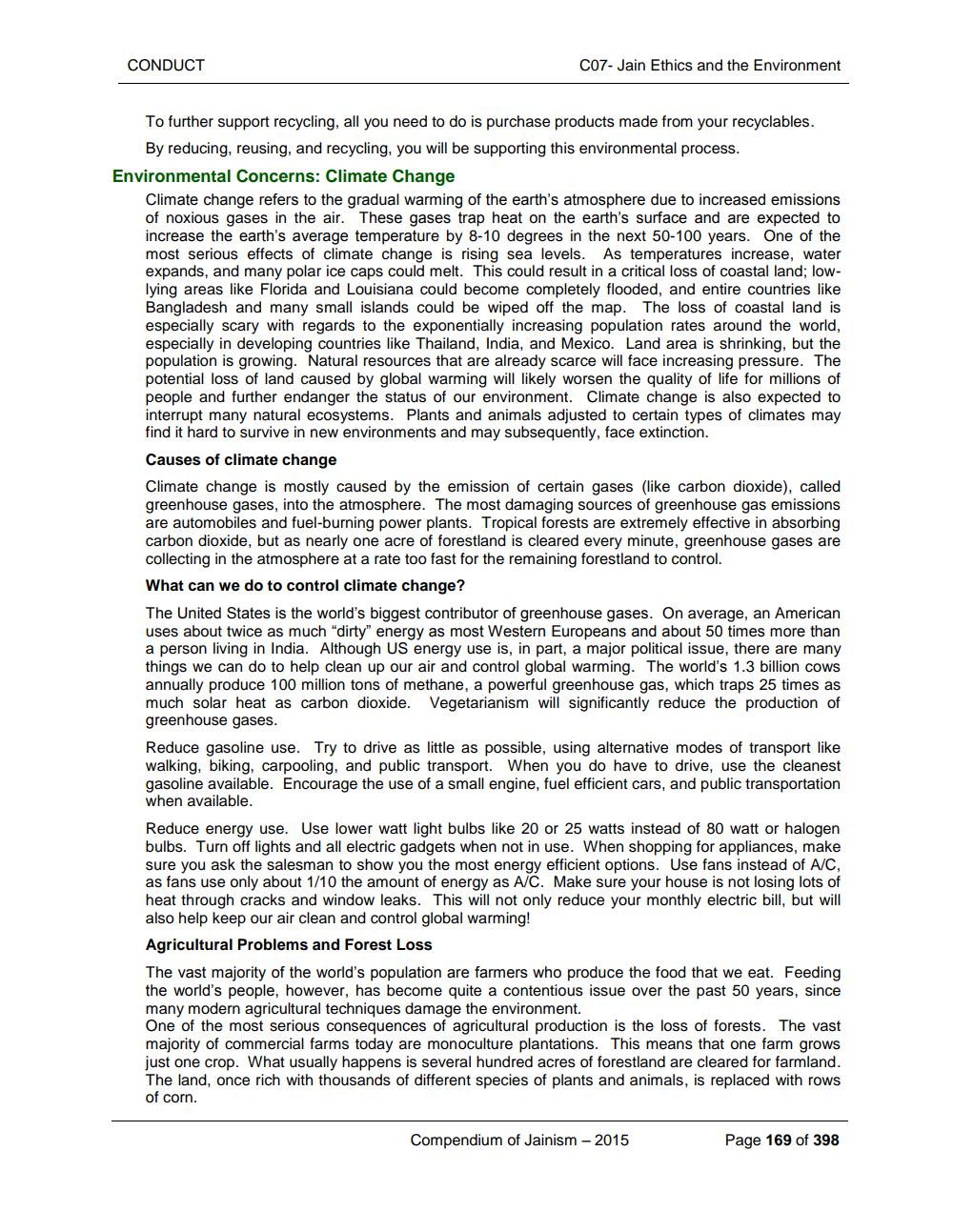________________
CONDUCT
C07- Jain Ethics and the Environment
To further support recycling, all you need to do is purchase products made from your recyclables.
By reducing, reusing, and recycling, you will be supporting this environmental process. Environmental Concerns: Climate Change
Climate change refers to the gradual warming of the earth's atmosphere due to increased emissions of noxious gases in the air. These gases trap heat on the earth's surface and are expected to increase the earth's average temperature by 8-10 degrees in the next 50-100 years. One of the most serious effects of climate change is rising sea levels. As temperatures increase, water expands, and many polar ice caps could melt. This could result in a critical loss of coastal land; lowlying areas like Florida and Louisiana could become completely flooded, and entire countries like Bangladesh and many small islands could be wiped off the map. The loss of coastal land is especially scary with regards to the exponentially increasing population rates around the world, especially in developing countries like Thailand, India, and Mexico. Land area is shrinking, but the population is growing. Natural resources that are already scarce will face increasing pressure. The potential loss of land caused by global warming will likely worsen the quality of life for millions of people and further endanger the status of our environment. Climate change is also expected to interrupt many natural ecosystems. Plants and animals adjusted to certain types of climates may find it hard to survive in new environments and may subsequently, face extinction. Causes of climate change Climate change is mostly caused by the emission of certain gases (like carbon dioxide), called greenhouse gases, into the atmosphere. The most damaging sources of greenhouse gas emissions are automobiles and fuel-burning power plants. Tropical forests are extremely effective in absorbing carbon dioxide, but as nearly one acre of forestland is cleared every minute, greenhouse gases are collecting in the atmosphere at a rate too fast for the remaining forestland to control. What can we do to control climate change? The United States is the world's biggest contributor of greenhouse gases. On average, an American uses about twice as much "dirty" energy as most Western Europeans and about 50 times more than a person living in India. Although US energy use is, in part, a major political issue, there are many things we can do to help clean up our air and control global warming. The world's 1.3 billion cows annually produce 100 million tons of methane, a powerful greenhouse gas, which traps 25 times as much solar heat as carbon dioxide. Vegetarianism will significantly reduce the production of greenhouse gases. Reduce gasoline use. Try to drive as little as possible, using alternative modes of transport like walking, biking, carpooling, and public transport. When you do have to drive, use the cleanest gasoline available. Encourage the use of a small engine, fuel efficient cars, and public transportation when available. Reduce energy use. Use lower watt light bulbs like 20 or 25 watts instead of 80 watt or halogen bulbs. Turn off lights and all electric gadgets when not in use. When shopping for appliances, make sure you ask the salesman to show you the most energy efficient options. Use fans instead of A/C, as fans use only about 1/10 the amount of energy as A/C. Make sure your house is not losing lots of heat through cracks and window leaks. This will not only reduce your monthly electric bill, but will also help keep our air clean and control global warming! Agricultural Problems and Forest Loss The vast majority of the world's population are farmers who produce the food that we eat. Feeding the world's people, however, has become quite a contentious issue over the past 50 years, since many modern agricultural techniques damage the environment. One of the most serious consequences of agricultural production is the loss of forests. The vast majority of commercial farms today are monoculture plantations. This means that one farm grows just one crop. What usually happens is several hundred acres of forestland are cleared for farmland. The land, once rich with thousands of different species of plants and animals, is replaced with rows of corn.
Compendium of Jainism - 2015
Page 169 of 398




